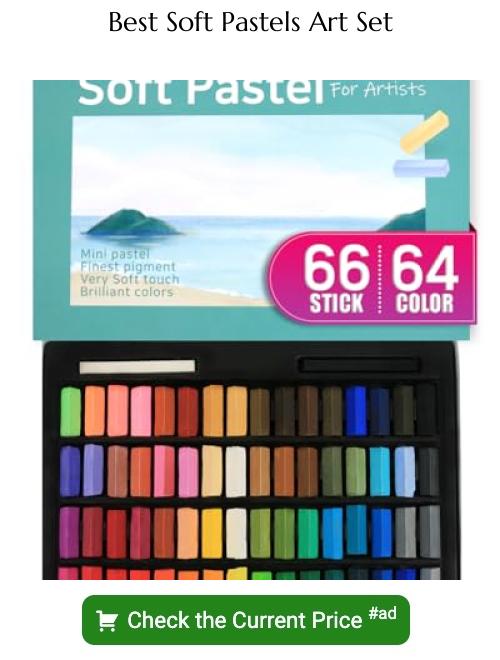Last updated on
Discover the differences between soft pastels and chalk pastels as you read on, ensuring you choose the right medium for your artwork.
Key takeaways:
- Soft pastels contain more pigment, resulting in vibrant colors.
- Chalk pastels have a dusty texture and are less pigmented.
- Soft pastels are ideal for blending and creating smooth transitions.
- Chalk pastels are better for crisp lines and detailed work.
- Consider the surface texture, level of detail, color vividness, durability, and desired technique when choosing between the two.
Composition of Soft Pastels
Soft pastels are made of pure pigment, the same found in all art mediums, combined with a minimal amount of binder to hold them together. This binder is typically a mixture of water and gum arabic or methylcellulose. As a result, they contain more pigment, which gives them their vibrant and intense colors.
Due to their high pigment content, they create a smooth texture that adheres well to a wide range of surfaces. These qualities make soft pastels ideal for creating rich, nuanced layers of color and for covering large areas with consistent color. Their softness also allows for easier blending, enabling artists to mix colors directly on their work surface to achieve soft transitions and a wide array of shades.
Composition of Chalk Pastels
Chalk pastels typically include calcium or magnesium carbonate, materials that give them their unmistakable dusty texture. They are known for their classroom-friendly properties, being non-toxic and thus often used in educational settings.
Moreover, these pastels are usually less pigmented compared to their soft pastel counterparts, offering a more subdued color palette. Their composition makes them slightly harder, which results in less intense color laydown, and makes them better suited for crisp lines and detailed drawing work.
As they adhere less to the paper, a fixative is usually required to preserve the artwork created with chalk pastels.
Color Intensity and Pigmentation
Soft pastels are renowned for their high pigment content, which results in vivid, rich colors. This high saturation is due to the minimal amount of binder used in their formulation, allowing the pure, fine-ground pigments to show their true brilliance when applied to a surface.
In comparison, chalk pastels contain a higher proportion of binder to pigment, which tends to dilute the color intensity. This composition yields more subdued hues, making chalk pastels a good choice for projects requiring a softer, more muted palette.
It’s worth noting that the heavy pigmentation of soft pastels can result in stronger color payoff with less effort. When layering or blending, these pastels maintain their vibrancy, whereas the lighter touch of chalk pastels may require additional layers to achieve a deeper coloration.
Artists seeking bold and dynamic shades often reach for soft pastels, while those desiring a more ethereal and delicate finish might opt for chalk pastels. The choice between the two ultimately depends on the desired outcome of the artwork.
Blendability of Soft Vs. Chalk Pastels
Soft pastels boast a higher pigment concentration, which leads to rich, opulent colors that blend seamlessly. Their buttery texture glides smoothly across the surface, allowing artists to merge hues with minimal effort. This blendability makes soft pastels ideal for creating gradients and subtle transitions in your artwork.
In contrast, chalk pastels contain a larger proportion of binder to pigment, yielding a firmer stick. This composition makes them less malleable, which can impact the fluidity of blending. You may notice that when layering colors, chalk pastels offer a more textured look, and the mixing of colors may require a bit more elbow grease.
For blended effects:
- Use your fingers or a blending tool to smudge soft pastels gently for a diffused look.
- Layer chalk pastels for a textured blend or use a dampened brush for watercolor effects.
- Experiment with underpainting techniques where the base layer is blended before adding additional layers.
Each type of pastel serves its purpose and choosing between them depends mainly on the desired finish and the texture you wish to achieve in your art project.
Choosing the Right Pastel for Your Project
When deciding between soft and chalk pastels for your artwork, consider the following factors:
1. Surface Texture: Soft pastels work best on textured paper or canvas that can hold the pigment, while chalk pastels are suitable for smoother surfaces.
2. Detail Work: For fine details, chalk pastels offer more control. Soft pastels are better suited to broad strokes and layering.
3. Vividness: If vibrant, intense colors are desired, soft pastels have a higher pigment concentration that delivers a powerful color payoff.
4. Durability: Artworks requiring longevity benefit from the staying power of soft pastels, which tend to be less brittle than their chalk counterparts.
5. Technique: Blending techniques and layering effects are more readily achieved with the buttery consistency of soft pastels, as opposed to the drier, harder chalk pastels.
6. Experimentation: Consider the project’s scope for experimentation. Soft pastels lend themselves to mixing and can create a wider range of hues and tints.
Your choice ultimately hinges on the desired finish and the nature of the project. Test both types on scrap material to get a feel for their handling and effect before committing to your final piece.
Recap:





